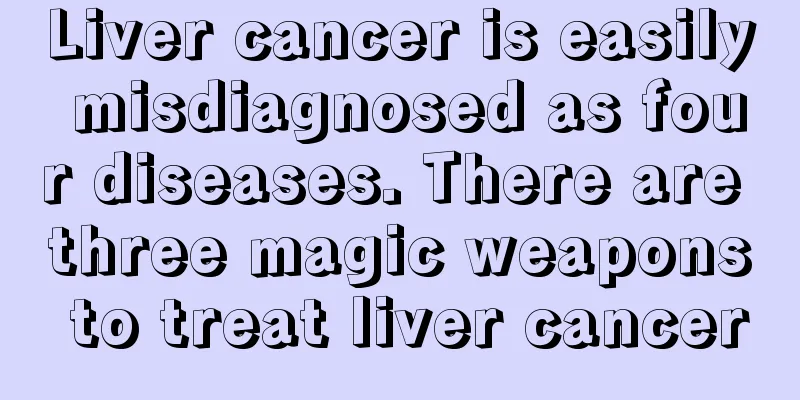Liver cancer is easily misdiagnosed as four diseases. There are three magic weapons to treat liver cancer

|
As the number of patients with liver disease increases, the number of patients with liver cancer also increases. Liver cancer has now become our second most common cancer, second only to lung cancer. This cancer often manifests as weight loss, fatigue, and severe pain. Once you are sick, the chance of recovery is small, so you should pay attention to your life and stay away from liver disease and liver cancer. Five major symptoms of liver cancer 1. Weight loss and fatigue This symptom often occurs in the middle and late stages of liver cancer. It may be that tumor metabolites cause changes in the body's biochemical metabolism, reduced food intake, and cachexia in severe cases. 2. Fever The fever caused by liver cancer is generally around 37.5'C~38℃, occasionally reaching above 39℃, with irregular fever pattern, often without chills. Fever is more common in the afternoon, and sometimes remittent high fever can also be seen. Fever can be caused by tumor necrosis or its metabolites. 3. Digestive tract symptoms Common symptoms include decreased appetite, upper abdominal fullness after meals, or even nausea, vomiting or diarrhea. 4. Pain This is a common symptom in patients with liver cancer. The pain is generally located in the liver area. The liver pain in patients with middle and late stage liver cancer is generally located in the right rib or under the xiphoid process. The nature of the pain is mostly persistent dull pain, dull pain or stabbing pain. A small number of patients may also have special manifestations of pain. Patients with liver cancer may also have referred pain in other parts of the body. The pain area of some patients is located in the upper and middle abdomen, which is mostly caused by left lobe liver cancer, but is sometimes misdiagnosed as stomach disease and delayed treatment. Some patients may experience right shoulder pain, which is clinically more common in tumors in the right lobe close to the diaphragm, because it involves the diaphragm and causes referred pain in the right shoulder, which is easily misdiagnosed as periarthritis of the shoulder. When liver cancer metastasizes to other parts of the body, symptoms of metastasis will appear. When it metastasizes to the lungs, chest pain may occur. When it metastasizes to the bones, bone pain may occur. Therefore, when liver cancer patients experience chest pain or bone pain, it should be considered that it is caused by liver cancer metastasis. Clinically, a small number of patients may experience sudden severe pain in the liver area, which is mostly caused by rupture and bleeding of cancerous nodules located on the surface of the liver. If the patient is also accompanied by dizziness, blurred vision, palpitations, and low blood pressure, it mostly indicates that the cancerous nodule has ruptured and is complicated by severe internal bleeding. If this happens, emergency rescue should be carried out in time. 5. Other symptoms Patients with hepatitis, cirrhosis or invasive tumor growth that causes liver decompensation may have a bleeding tendency, such as nosebleeds, gingival and subcutaneous ecchymosis, etc.; hypoproteinemia may also occur, leading to edema, ascites, abdominal distension, etc. Four diseases are easily misdiagnosed as liver cancer Granuloma: Some female patients may have isolated, smooth, and complete nodules in the liver due to oral contraceptives, parasitic infections, or autoimmune disorders, which are difficult to distinguish from liver cancer on imaging. It is recommended to perform histological examination under ultrasound or CT guidance. Cirrhotic nodules: Cirrhosis nodules are most likely to be diagnosed as liver cancer, because most primary liver cancers will develop into cirrhosis, and patients with severe cirrhosis will have a large number of hyperplastic nodules, which are difficult to distinguish from early liver cancer. It is recommended to perform an ultrasound or CT-guided puncture biopsy for accurate diagnosis. Liver abscess: Patients have clinical manifestations such as fatigue, low fever, weight loss, and discomfort in the liver area. It is difficult to distinguish them from liver cancer in the early stage of the disease, and a comprehensive judgment is needed based on biochemical indicators such as blood routine, AFp, and liver function. Hepatic hemangioma: Hepatic hemangioma and hepatocellular carcinoma are easily confused. In fact, hemangioma grows slowly and generally has no history of chronic liver disease. There are no clinical manifestations such as fatigue, poor appetite, abdominal distension, etc., and there will be no physical signs such as liver palms, spider nevi, jaundice, and edema of both lower limbs. Uneven fatty liver: Some patients with fatty liver have uneven fat accumulation, which is sometimes difficult to distinguish from liver cancer. Clinically, fatty liver does not have the systemic manifestations of liver cancer patients, such as abdominal distension, diarrhea, discomfort in the right liver area, and weight loss. How to diagnose liver cancer? B-ultrasound can only detect suspicious nodules. CT or MRI is needed to confirm the diagnosis. If enhanced CT has the characteristic of "fast in and fast out" of contrast agent, it can generally confirm the diagnosis. Alpha-fetoprotein is a marker for diagnosing liver cancer, but an increase in its level does not necessarily mean liver cancer; nor does an increase in its level necessarily mean liver cancer. Liver cancer diagnosis generally does not require puncture, as cancerous nodules smaller than 3 cm are difficult to puncture and may cause tumor spread along the path of the puncture needle. Introduction to three magic weapons for treating liver cancer Surgery, radiotherapy and chemotherapy are the "three magic weapons" for treating cancer, and are also the most commonly used and important treatments for liver cancer. 1. Surgical treatment To date, surgical resection is still the most commonly used and most effective treatment for malignant tumors, including liver cancer, and is the main way for most cancer patients to be cured. Since liver cancer is often discovered late, or patients cannot tolerate surgery due to combined liver cirrhosis, the resection rate is not high, so early prevention, early detection, and early treatment are advocated. With the continuous deepening of research on early detection and treatment of liver cancer, the diagnostic level and technology are constantly improving, liver cancer can be detected in the early, asymptomatic stage, which can give more and more early liver cancer patients the opportunity to undergo surgical resection, and the effect is significantly improved. 2. Radiation therapy Radiotherapy is a treatment method that uses radiation to directly kill pathogenic tumor cells. In the past, radiotherapy was the first choice for non-surgical treatment of liver cancer, but in recent years it has become less popular due to the development of radiointervention and other local treatments. Radiotherapy is suitable for patients whose liver tumors cannot be removed and who are not suitable or willing to undergo radiotherapy intervention. Clinical practice in recent years has found that the combination of radiotherapy and radiotherapy intervention can significantly improve the efficacy of radiotherapy. In addition, radiotherapy for local recurrence, lymph node metastasis and adrenal metastasis can achieve better results. The combination of radiotherapy with surgery, chemotherapy, immunotherapy, traditional Chinese medicine and other treatment methods is conducive to further improving the efficacy. 3. Chemotherapy and radiotherapy Chemotherapy is the application of chemical drugs for treatment. In the past half century, chemotherapy has developed from the single application of a few chemotherapy drugs to the combined application of multiple drugs. In addition to the original intravenous systemic chemotherapy, new methods of administration have also emerged, such as adjuvant chemotherapy, neoadjuvant chemotherapy, and special chemotherapy (arterial, intracavitary perfusion, etc.). Since chemotherapy drugs can cause damage to the patient's body while destroying cancer cells, it is currently not recommended to use systemic intravenous chemotherapy for liver cancer patients in clinical practice, but to use less harmful radiological interventional therapy. |
Recommend
What are the treatments for cervical cancer? There are 3 common misunderstandings about cervical cancer treatment
What is the treatment for cervical cancer? First ...
Can early bladder cancer survive long term after surgery?
Can patients with early bladder cancer survive lo...
Which department should I go to for hematuria
The causes of hematuria come from many factors, s...
Is there any good way to solve tinnitus?
Tinnitus is a relatively common symptom. There ar...
Where is the appendix in the human body?
If you have an irregular lifestyle and don't ...
Can anti-inflammatory drugs and antiviral drugs be taken together?
Anti-inflammatory drugs are a type of antibiotics...
How much does nasopharyngeal carcinoma virus screening cost
Nasopharyngeal cancer is a symptom of cancer in t...
How to remove blackheads on legs?
Everyone wants their skin to be smooth and elasti...
Let’s take a look at some snacks suitable for drinking beer
Beer is an indispensable drink for various gather...
Why do fingers wrinkle when soaked in water?
Fingers are parts of the body that people pay gre...
The difference between sorghum rice and coix seed
Sorghum rice and coix seed are two completely dif...
There is a circle-shaped skin disease on the body
Circle-shaped skin diseases on the body are likel...
What are the benefits of breathing through the nose
Some body functions decline with age, which may c...
What to do if pus comes out after ear piercing
Many girls love beauty. When I see other people w...
How to prevent breast cancer? Pay attention to these 3 points in the prevention and treatment of breast cancer
We should do a good job in the prevention and tre...









